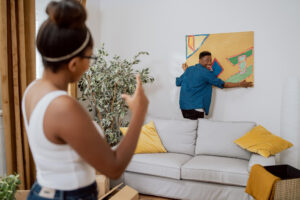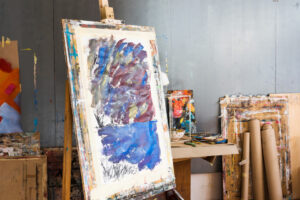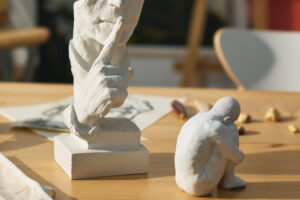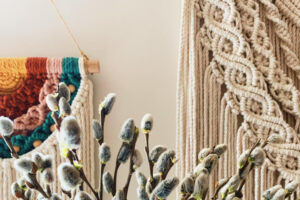 Art has always been an integral part of interior design. It is more than just a decorative element; it has the power to transform a space entirely. The art pieces in a room are not just there to look pretty; they play a crucial role in creating the atmosphere and character of a space. The amalgamation of art and interior spaces is a delicate and nuanced dance that goes beyond aesthetics. It influences the ambiance of a room, creating a sense of warmth and tranquility or vibrancy and energy.
Art has always been an integral part of interior design. It is more than just a decorative element; it has the power to transform a space entirely. The art pieces in a room are not just there to look pretty; they play a crucial role in creating the atmosphere and character of a space. The amalgamation of art and interior spaces is a delicate and nuanced dance that goes beyond aesthetics. It influences the ambiance of a room, creating a sense of warmth and tranquility or vibrancy and energy.
This intricate relationship between art and the overall atmosphere of a room is the cornerstone of a well-designed living space. It is essential to choose art pieces that complement the room’s color scheme, furniture, and lighting to create a cohesive and harmonious space. Properly integrating art into a room can elevate the design, create a focal point, and infuse the space with personality and emotion.
Choosing the Right Artwork
Elevating the interior of a space requires a thoughtful selection of artwork, arranged strategically. The process of creating visual interest begins with the selection of key pieces that will serve as focal points, directing attention and establishing a sense of hierarchy within the room. This placement must be done with care, taking into account the height and spacing of the artwork to achieve the desired effect.
The goal is to achieve a harmonious balance that showcases the artwork effectively without detracting from the overall aesthetic appeal of the space. To create a truly captivating display, it’s essential to mix different types of artwork. This introduces an exciting level of complexity, adding a dynamic layer to the space that speaks to the unique tastes and preferences of its occupants.
Placement and Arrangement
 Elevating the interior of a space requires a thoughtful selection of artwork, arranged in a strategic manner. The process of creating visual interest begins with the selection of key pieces that will serve as focal points, directing attention and establishing a sense of hierarchy within the room. This placement must be done with care, taking into account the height and spacing of the artwork to achieve the desired effect.
Elevating the interior of a space requires a thoughtful selection of artwork, arranged in a strategic manner. The process of creating visual interest begins with the selection of key pieces that will serve as focal points, directing attention and establishing a sense of hierarchy within the room. This placement must be done with care, taking into account the height and spacing of the artwork to achieve the desired effect.
The goal is to achieve a harmonious balance that showcases the artwork effectively without detracting from the overall aesthetic appeal of the space. To create a truly captivating display, it’s essential to mix different types of artwork. This introduces an exciting level of complexity, adding a dynamic layer to the space that speaks to the unique tastes and preferences of its occupants.
Lighting and Art
 When it comes to integrating art into a space, proper lighting is often an overlooked yet critical element. It is the unsung hero that not only enhances the artwork but also influences the overall mood of the room. The right lighting can bring out even the smallest details of a painting, highlighting its unique features and making it stand out. It can also create dynamic shadows around a sculpture, making it appear more dramatic and powerful.
When it comes to integrating art into a space, proper lighting is often an overlooked yet critical element. It is the unsung hero that not only enhances the artwork but also influences the overall mood of the room. The right lighting can bring out even the smallest details of a painting, highlighting its unique features and making it stand out. It can also create dynamic shadows around a sculpture, making it appear more dramatic and powerful.
By striking a balance between natural and artificial light, the artwork is showcased optimally, offering a nuanced perspective that evolves with the changing light conditions. In other words, lighting is a crucial component in elevating the visual impact of art, making it an essential consideration when designing any space that features art.
Art and Furniture Harmony
 The process of achieving a harmonious balance between artwork and furniture is an art form that requires an eye for detail and a keen sense of design. When artwork is thoughtfully selected and displayed in a way that complements the surrounding decor, it creates a cohesive and visually appealing design language that resonates throughout the entire room. To achieve this, careful consideration must be given to factors such as the scale of the artwork in relation to the furniture, the color palette and style of the artwork and furniture, and the overall aesthetic of the space.
The process of achieving a harmonious balance between artwork and furniture is an art form that requires an eye for detail and a keen sense of design. When artwork is thoughtfully selected and displayed in a way that complements the surrounding decor, it creates a cohesive and visually appealing design language that resonates throughout the entire room. To achieve this, careful consideration must be given to factors such as the scale of the artwork in relation to the furniture, the color palette and style of the artwork and furniture, and the overall aesthetic of the space.
By ensuring a seamless blend that prevents clashes and disruptions to the visual flow, the space can be balanced in a way that neither overpowers nor underwhelms its occupants. It is a delicate equilibrium that requires a keen eye, but when achieved, the result is a stunning display of art and design that enhances the overall ambiance of the room.
Showcasing Collections
 If you are passionate about art and have a variety of artworks that you cherish, you can transform a room into a stunning gallery by showcasing your collection cohesively and thoughtfully. By arranging diverse pieces in a way that complements each other, you are not only celebrating your personal tastes but also creating a beautiful visual story that reflects your personality and artistic journey.
If you are passionate about art and have a variety of artworks that you cherish, you can transform a room into a stunning gallery by showcasing your collection cohesively and thoughtfully. By arranging diverse pieces in a way that complements each other, you are not only celebrating your personal tastes but also creating a beautiful visual story that reflects your personality and artistic journey.
A gallery wall is a great way to display multiple artworks in a creative and eye-catching way. It can turn an empty wall into a dynamic masterpiece that will be the centerpiece of any room. With careful planning and attention to detail, you can create a beautiful and unique gallery that will impress your guests and inspire you every time you enter the space.
Types of Artwork
Here are some modern artworks that you can incorporate into your interior design:
Paintings and Canvas Prints
 Canvas prints and paintings are exquisite works of art that can serve as focal points in any space. Their vibrant hues, intricate details, and unique stories evoke powerful emotions and captivate the viewer’s imagination. Whether you’re an art connoisseur or a casual admirer, these timeless pieces are sure to add depth and character to your home or office.
Canvas prints and paintings are exquisite works of art that can serve as focal points in any space. Their vibrant hues, intricate details, and unique stories evoke powerful emotions and captivate the viewer’s imagination. Whether you’re an art connoisseur or a casual admirer, these timeless pieces are sure to add depth and character to your home or office.
Sculptures and 3D Art
 By incorporating sculptures and 3D art, we can add an extra dimension to our surroundings. This added dimensionality can transform a space from being a mere visual experience to one that is fully immersive, engaging all of our senses and creating a lasting impression. Whether it’s a bold statement piece or a subtle accent, sculptures and 3D art have the power to elevate any environment.
By incorporating sculptures and 3D art, we can add an extra dimension to our surroundings. This added dimensionality can transform a space from being a mere visual experience to one that is fully immersive, engaging all of our senses and creating a lasting impression. Whether it’s a bold statement piece or a subtle accent, sculptures and 3D art have the power to elevate any environment.
Textile Art and Wall Hangings
 Artwork can add texture and warmth to a space, making it feel cozy and inviting. It can also showcase skilled craftsmanship and cultural influences, making it visually appealing and a canvas for cultural expressions.
Artwork can add texture and warmth to a space, making it feel cozy and inviting. It can also showcase skilled craftsmanship and cultural influences, making it visually appealing and a canvas for cultural expressions.
Conclusion
The integration of artwork into interior design is a meticulous process that goes beyond mere decoration. It involves a thoughtful curation of pieces that resonate with the room’s purpose, style, and color scheme. From strategic placement and arrangement to considering various types of artwork, the art of design is a multi-faceted journey. Lighting, furniture, and the showcasing of collections add layers of complexity to this intricate dance between art and space.
Ultimately, the encouragement for readers to experiment and express their style reinforces the idea that embracing art is an opportunity for personal expression and creativity within their living spaces. As the walls become a canvas, the room transforms into a living, breathing masterpiece that reflects the unique identity of its occupants.
Ready to turn your dream home into reality? Book an appointment with E³.SPACE, and let us bring your vision to life.
